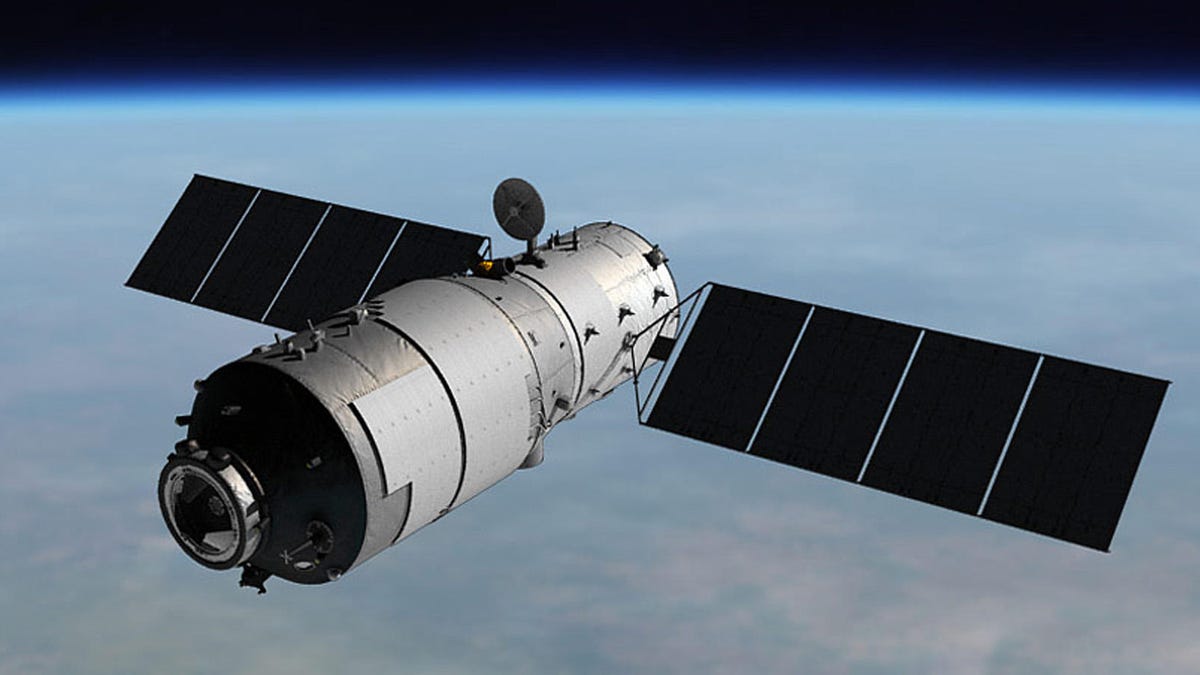China's uncontrolled space station could crash to Earth soon
Tiangong-1 launched in 2011. Now it's coming home at very high speeds without a steering wheel, with the latest reentry predictions closing in around April 1.

An artist's rendition of Tiangong-1 in orbit.
It's becoming more likely that China's space station known as "Heavenly Palace 1" could play a very serious April Fool's prank on our planet.
The latest prediction of when the out-of-control spacecraft is likely to slam into Earth's atmosphere and perhaps make it, in part, all the way to the surface of our planet continues to close in around April 1.
On Saturday the European Space Agency narrowed the range for Tiangong-1's (its Chinese name) likely re-entry to between March 30 and April 2.
The latest updates from other orbit watchers -- including the Center for Orbital and Reentry Debris Studies and academic researchers -- have also narrowed the window for Tiangong-1's entry to somewhere around April 1, plus or minus about four days.
In other words, the 18,740-pound (8,500-kilogram) spacecraft is currently expected to go out in a final blaze of glory sometime between March 28 and April 5.
This range could still change, but the window has begun to shrink significantly in recent days as Tiangong-1's demise approaches.
The Fraunhofer Institute for High Frequency Physics and Radar Techniques recently caught the doomed space station, which launched in 2011, via radar as Earth's gravity continues to slowly pull it ever closer to home.
Worldwide unique radar images of Tiangong-1!
— Fraunhofer FHR engl. (@Fraunhofer_FHRe) March 21, 2018
Researchers at Fraunhofer FHR monitor re-entry of Chinese space station Tiangong-1 #reentry #Tiangong1 #radar #radarimage #spacedebris https://t.co/WtVSR6omIt pic.twitter.com/QBCit0dp3v
Some things to keep in mind about Tiangong-1's re-entry:
It's impossible to predict where it might land, as I explained in a previous post, because it's likely unsteerable and moving incredibly fast.
It could re-enter anywhere between 43 degrees north and south of the equator, which is a huge swath of land and ocean stretching from the northern contiguous United States to Tasmania in the south. Congratulations, Canada, you're totally safe except for a little piece of Ontario.
The yellow bands indicate the areas where Tiangong-1 is most likely to re-enter the atmosphere. Green is less likely and blue is unlikely.
There's no guarantee any parts of Tiangong-1 will survive its scorching flight through the atmosphere.
If pieces do make it to the surface, they'll likely fall in the ocean or the middle of nowhere. Only one person has ever reported being hit by falling space debris. It happened to a woman in Oklahoma and she was not injured.
If you do come across parts of it, stay away and call authorities because it may contain toxic propellants like hydrazine.
If you see Tiangong-1 streaking across the sky, take a video and tweet it at me @EricCMack.
Stay tuned for more updates as the Heavenly Palace's fall from the heavens draws closer.
First published March 22, 12:22 p.m. PT.
Update, March 24 at 5:45 p.m. PT: Adds new predictions from ESA.
Crowd Control: A crowdsourced science fiction novel written by CNET readers.
Solving for XX: The tech industry seeks to overcome outdated ideas about "women in tech."

